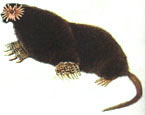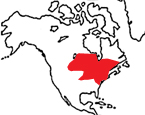|
Star-nosed
Mole
(Condylura cristata) |
||||
|
|
Physical
characteristics and distribution
|
|
The
body length of C. cristata is 100-127 mm, tail length
is 56-84 mm. Adults weigh from 40-85 grams. They have dense,
coarse black-brown fur which is water repellant. Their distinctive
feature is the 22 fleshy appendages surrounding its muzzle.
These are known as rays or tentacles, which except for the two
median upper tentacles, are in constant motion when the animal
is in search of food. A
large portion of its food is found on the bottom of streams
and ponds including aquatic insects, crustaceans, small fish
and earthworms. |
|
Description
of the brain
|
|
Animal
source and preparation
|
|
All specimens collected followed the same preparation and histological procedure.
|
Other Related Resources (websites and publications)
List of Specimens | Explore Collections | Brain Sections | Brain Evolution | Brain Development | Brain Circuitry | Brain Functions | Location and Use | Related Web Sites | Contact Us | Search MSU Database | Personnel | Home



